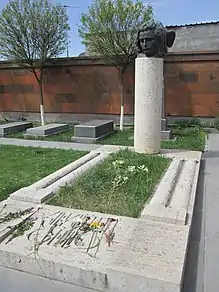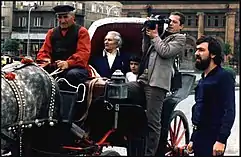Hovhannes Shiraz
Hovhannes Shiraz (Armenian: Հովհաննես Շիրազ) (April 27, 1914 – March 14, 1984) was an Armenian poet.
Hovhannes Shiraz | |
|---|---|
 | |
| Born | Onik Tadevosi Karapetyan 27 April 1914 Alexandropol, Russian Empire |
| Died | 24 March 1984 (aged 69) Yerevan, Soviet Armenia |
| Resting place | Komitas Pantheon |
| Occupation | Poet |
| Nationality | Armenian |
| Genre | Lyric poetry |
| Spouse | Silva Kaputikyan, Shushanik Aristakesyan |
| Children | Ara Shiraz, Sipan Shiraz, Vanand Shiraz, Masis Shiraz |
Biography
Shiraz was born Onik Tadevosi Karapetyan in the city of Alexandropol, then part of the Russian Empire (now Gyumri, Armenia). His mother, Astghik, was widowed by the Armenian Genocide shortly before his birth. [1] Shiraz grew up in a considerable poverty. His first work called Beginning of Spring was published in 1935. Novelist Atrpet gave the talented poet the epithet "Shiraz", because "this youth's poems have the fragrance of roses, fresh and covered with dew, like the roses of Shiraz" (Shiraz being one of Iran's major cities, famous for its roses and poets). Another version of his pen name is "Shirak azn"—a child of Shirak, the region he was from.[2]
In 1937 Hovhannes Shiraz entered the Armenian Literature Department of Yerevan's State University, where he studied until 1941. He also studied at the Moscow Maxim Gorky Literature Institute. In 1958, he published the first volume of his anthology Knar Hayastani (Lyre of Armenia).[3] The second and third volumes were published in 1965 and 1974. These collections include the best examples of Shiraz's poetry.[4]

Shiraz mostly wrote and published poetry. He is an author of very popular patriotic and love poems included "Ani", "My Mother", "May my love remain a secret", "Siamanto and Khjezare", "Expromptu", "Like the Pagan Love", "My Holy Homeland", "The Fate of Armenians", "To Andranik", etc. He wrote "The Armenian Dante-esque" about the Armenian genocide, a subject that was banned in Soviet Union. The first version of this masterpiece was written in 1941.[5] Only short passages from this work were published in Soviet Armenia during his lifetime, and some chapters were published in Beirut and Tehran. The entire poem (over 8000 lines) was published in 1990 in Yerevan.
He was buried at Komitas Pantheon,[6] in Yerevan, along with other distinguished Armenians.
He first married famous Armenian poet Silva Kaputikyan. His son with Kaputikyan, Ara Shiraz, was a sculptor. Shiraz had seven children with his second wife, Shushanik Shiraz (Aristakesyan, 1937-2006),[7] one of whom was Sipan Shiraz, a poet.
Yerevan school #169 and a street in Julfa, Isfahan are named after him. The Hovhannes Shiraz House-Museum is located in a nineteenth-century building in Gyumri.[8]
Personality
Shiraz was known for his good sense of humour. In 1963 John Steinbeck visited poet's apartment in Yerevan, and then wrote in a letter: "...men are closest together when they laugh together. And I remember that in Yerevan we laughed together a great deal."[9]
Yevgeny Yevtushenko[10] and Alexander Gitovich[11] dedicated poems to Shiraz.
Shiraz was an anti-establishment poet who was very popular with the people of Soviet Armenia but fought against its corrupt Soviet leadership all his life.[12] When in 1974 the known critic Suren Aghababyan brought to Shiraz the news about awarding of the Order of Lenin, his answer followed: "And what they [the Soviet government] want in exchange? To buy my silence?"[4]
Poetry
Shiraz is an author of about forty poetry books and translations. His rich vocabulary and sensitive style, enhanced by folk and colloquial elements,[13] made his poetry one of the highest achievements of Armenian literature. Critics consider many of his works masterpieces. According to Paruyr Sevak, "The modern Armenian poetry has risen on the ridge of Shiraz".[4] "Shiraz is a great talent, we should be proud and consider as a great honor that we personally know him", wrote William Saroyan. Shiraz built his poems with Armenian "tuff of emotions", added Yevgeny Yevtushenko.[14]
In my dreams my door was knocked at,
"Who is it?" I asked from inside.
Some elderly lady from the outside
Answered and said, "I'd sacrifice myself for you."
"I've come to ask for a piece of bread as charity
I'm a poor orphan woman with no one to support me."
At this point I opened my door immediately,
Only to find a miracle; it was my deceased mother indeed!
I was shocked but fell into her arms;
And my mother said, "It's me, it's me,
I've come to try you and to check on you.
I hope life hasn't changed your spirit and also you?!"
I came in the form of a beggar
So that the whole world can be a witness
To see if your conscience, my dear son,
If your conscience also died along with me?!"
(Translated from Armenian by Daniel Janoyan)
Poems of Shiraz are known throughout the former USSR (his works were translated by Arseny Tarkovsky and Nikolay Aseev) and abroad. As Andrey Dementyev writes, Hovhannes Shiraz, like Sergey Yesenin, uses many metaphors, so it's very hard to translate his poems.[15]
During a meeting with Soviet writers, to demonstrate what kind of poetry he liked best, Hindi writer Bhisham Sahni, showed a journal containing poems by Hovhannes Shiraz.[16]
House-Museum
The Hovhannes Shiraz House-Museum is located on Varpetats Street, Gyumri. The house was presented to Shiraz by Soviet Armenian officials in July 1983. The house was built in 1886 and belonged to a millionaire. During the Soviet Union it was used as a storehouse. Due to the 1988 Armenian earthquake, the museum’s refurbishment was interrupted, and 8 homeless families found shelter in the house. In 2003 it became a house-museum by the resolution of the Armenian government.
Selected bibliography
- Beginning of Spring, 1935
- Song of Armenia, 1940
- The voice of poet, 1942
- A book of songs, 1942
- Biblian, 1944
- Lyre of Armenia, three volumes, 1958, 1965 and 1974
- A monument to my Mother, 1968
- Peace to everybody, 1982

Filmography
- "Hovhannes Shiraz: A Documentary", 2005, director Levon Mkrtchyan
- "On the Path to Eternity", Armenfilm, 1983, 35mm, director Levon Mkrtchyan, composer Sarkis Aladjadjyan
References
- Armenia: with Nagorno Karabagh, Nicholas Holding, 2006, p. 40
- "Hovhannes Shiraz, Orientalistica". Archived from the original on 2016-12-26. Retrieved 2013-10-04.
- Razmik Panossian, The Armenians: From Kings and Priests to Merchants and Commissars (Columbia University Press, 2006), 335.
- "МОЯ БИОГРАФИЯ – ЭТО МОИ СТИХИ", 2010 Archived 2012-04-25 at the Wayback Machine
- The Armenian genocide: cultural and ethical legacies, By Richard G. Hovannisian, p. 103
- Shiraz's memorial tombstone at Komitas Pantheon
- Shushanik Shiraz
- House-Museums of Writers Archived 2013-04-16 at Archive.today
- The Fragrance of the Roses Lingers On ... Hovhannes Shiraz
- Первое собрание сочинений в восьми томах: 1976–1982, Евгений Александрович Евтушенко
- Подольный И. Что было, то было: Записки счастливого человека. – Вологда, 2001
- "Hovhannes Shiraz, by Shant Norashkharian". Archived from the original on 2017-03-26. Retrieved 2012-01-21.
- Calendar of literary facts: a daily and yearly guide, by Samuel J. Rogal – 1991
- Е. Евтушенко, Талант есть чудо неслучайное, 1980, с. 216
- Поэт Андрей ДЕМЕНТЬЕВ, Bulvar Gordona, № 34 (329) 2011
- Soviet literature, journal, 1987, p. 156
External links
| Armenian Wikisource has original text related to this article: |
